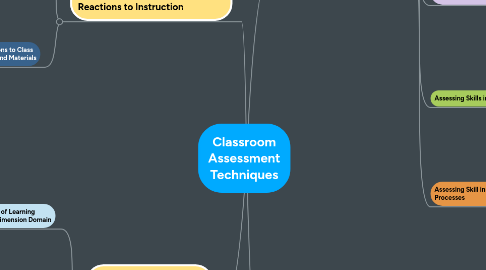
1. Techniques for Assessing Learner Reactions to Instruction
1.1. Assessing Learner Reactions to Teachers and Teaching
1.1.1. Chain Notes
1.1.2. Electronic Mail Feedback
1.1.3. Teacher-Designed Feedback Forms
1.1.4. Group Instructional Feedback Technique
1.1.5. Classroom Assessment Quality Circles
1.2. Assessing Learner Reactions to Class Activities, Assignments, and Materials
1.2.1. Recall, Summarize, Question, Connect, and Comment
1.2.2. Group-Work Evaluations
1.2.3. Reading Rating Sheets
1.2.4. Assignment Assessments
1.2.5. Exam Evaluations
2. Techniques for Assessing the Human Dimension Domain
2.1. Assessing Achievement of Learning Regarding the Human Dimension Domain
2.1.1. Free Discussion
2.1.2. Nominations
2.1.3. Editorial Review
2.1.4. Dramatic Dialogues
2.1.5. Role Play
2.1.6. Ethical Delimma
2.1.7. Digital Story
2.2. Assessing for the Caring Domain
2.2.1. Stand Where You Stand
2.2.2. Three-Minute Message
2.2.3. Issue Awareness Ad
2.2.4. Proclomations
2.2.5. Editorial
2.2.6. Debate
2.2.7. Briefing Paper
3. Techniques for Assessing Course-Related Knowledge and Skills
3.1. Assessing Prior Knowledge, Recall, and Understanding
3.1.1. Background Knowledge Probe
3.1.2. Focused Listening
3.1.3. Misconception/Preconception Check
3.1.4. Empty Outlines
3.1.5. Memory Matrix
3.1.6. Minute Paper
3.1.7. Muddiest Point
3.2. Assessing Skills in Analysis and Critical Thinking
3.2.1. Categorizing Grid
3.2.2. Defining Features Matrix
3.2.3. Pro and Con Grid
3.2.4. Content, Form, and Function Outlines
3.2.5. Analytic Memos
3.3. Assessing Skill in Synthesis and Creative Thinking
3.3.1. One Sentence Summary
3.3.2. Word Journal
3.3.3. Approximate Analogies
3.3.4. Concept Maps
3.3.5. Invented Dialogues
3.3.6. Annotated Portfolios
3.4. Assessing Skills in Problem Solving
3.4.1. Problem Recognition Tasks
3.4.2. Documented Problem Solutions
3.4.3. Audio and Videotaped Protocols
3.4.4. What's the Principle?
3.5. Assessing Skill in Application and Processes
3.5.1. Directed Paraphrasing
3.5.2. Applications Cards
3.5.3. Student-Generated Test Questions
3.5.4. Human Tableau or Class Modeling
3.5.5. Paper or Project Prospectus
4. Techniques for Assessing Learner Attitudes, Values, and Self-Awareness
4.1. Assessing Student's Awareness of Their Attitudes and Values
4.1.1. Classroom Opinion Polls
4.1.2. Double-Entry Journals
4.1.3. Profiles of Admirable Individuals
4.1.4. Everyday Ethical Dilemmas
4.1.5. Course-Related Self-Confidence Surveys
4.2. Assessing Students' Self-Awareness as Learners
4.2.1. Focused Autobiographical Sketches
4.2.2. Interest/Knowledge/Skills Checklists
4.2.3. Goal Ranking and Matching
4.2.4. Self-Assessment of Ways of Learning
4.3. Assessing Course Related Learning and Study Skills, Strategies, and Behaviors
4.3.1. Productive Study-Time Logs
4.3.2. Punctuated Lectures
4.3.3. Process Analysis
4.3.4. Diagnostic Learning Logs
